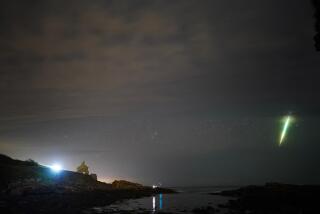Star Tours
- Share via
The annual Perseid meteor shower peaks today. Observers in a dark location might see up to one meteor a minute late tonight. Meteors come from dust shed by comets long ago. If the Earth passes near a comet’s orbit, it sweeps up dust particles that fall as fiery meteors. They burn up through air friction like a returning spacecraft without a heat shield. Perseid meteors radiate from the direction of the constellation Perseus, which is in the northeast. A few Perseid meteors will fall Friday and Saturday nights. NASA will show live pictures of the meteors taken by a digital camera in a balloon on the Internet at https://www.perseidslive.com.
* Source: John Mosley, Griffith Observatory; Times staff
More to Read
Sign up for The Wild
We’ll help you find the best places to hike, bike and run, as well as the perfect silent spots for meditation and yoga.
You may occasionally receive promotional content from the Los Angeles Times.






